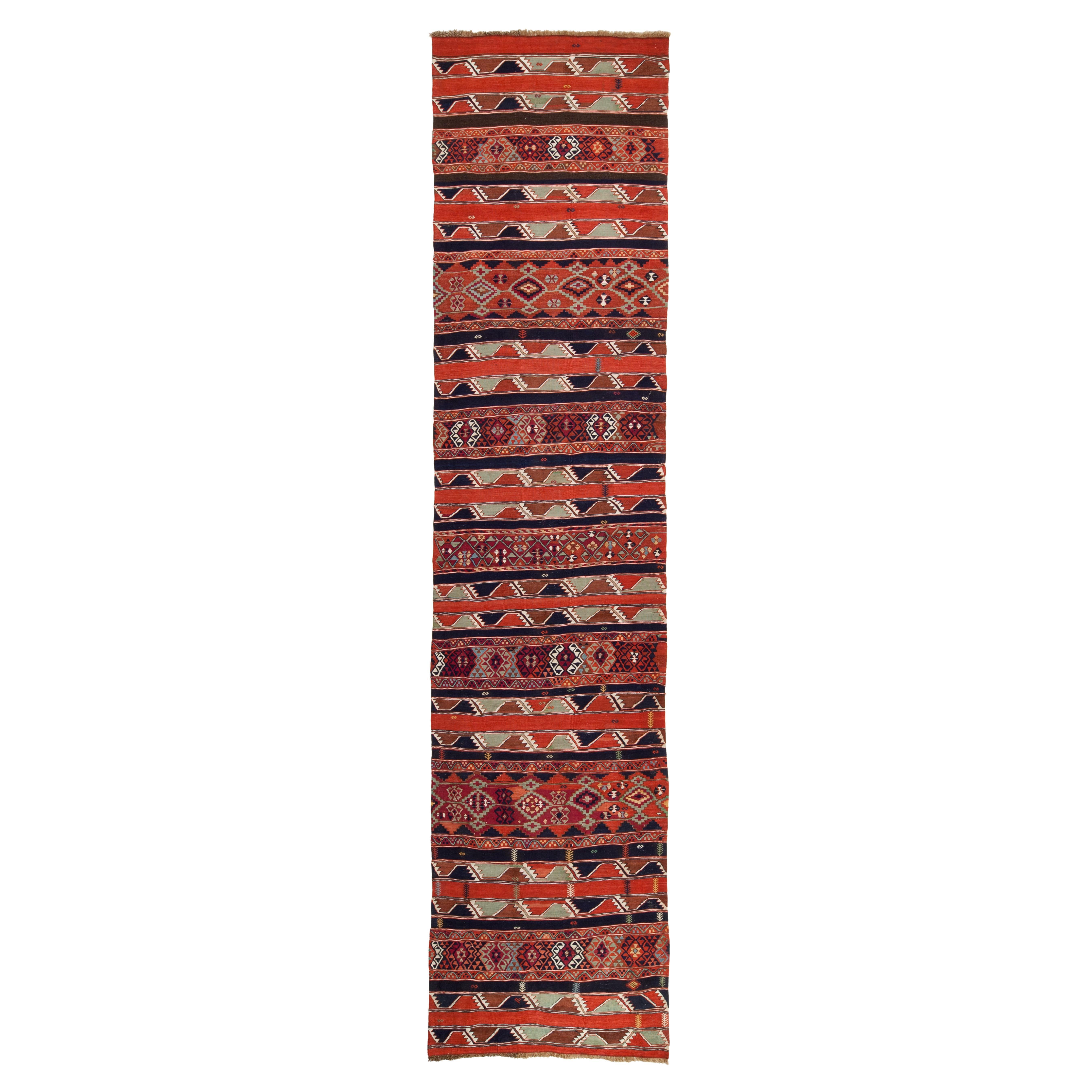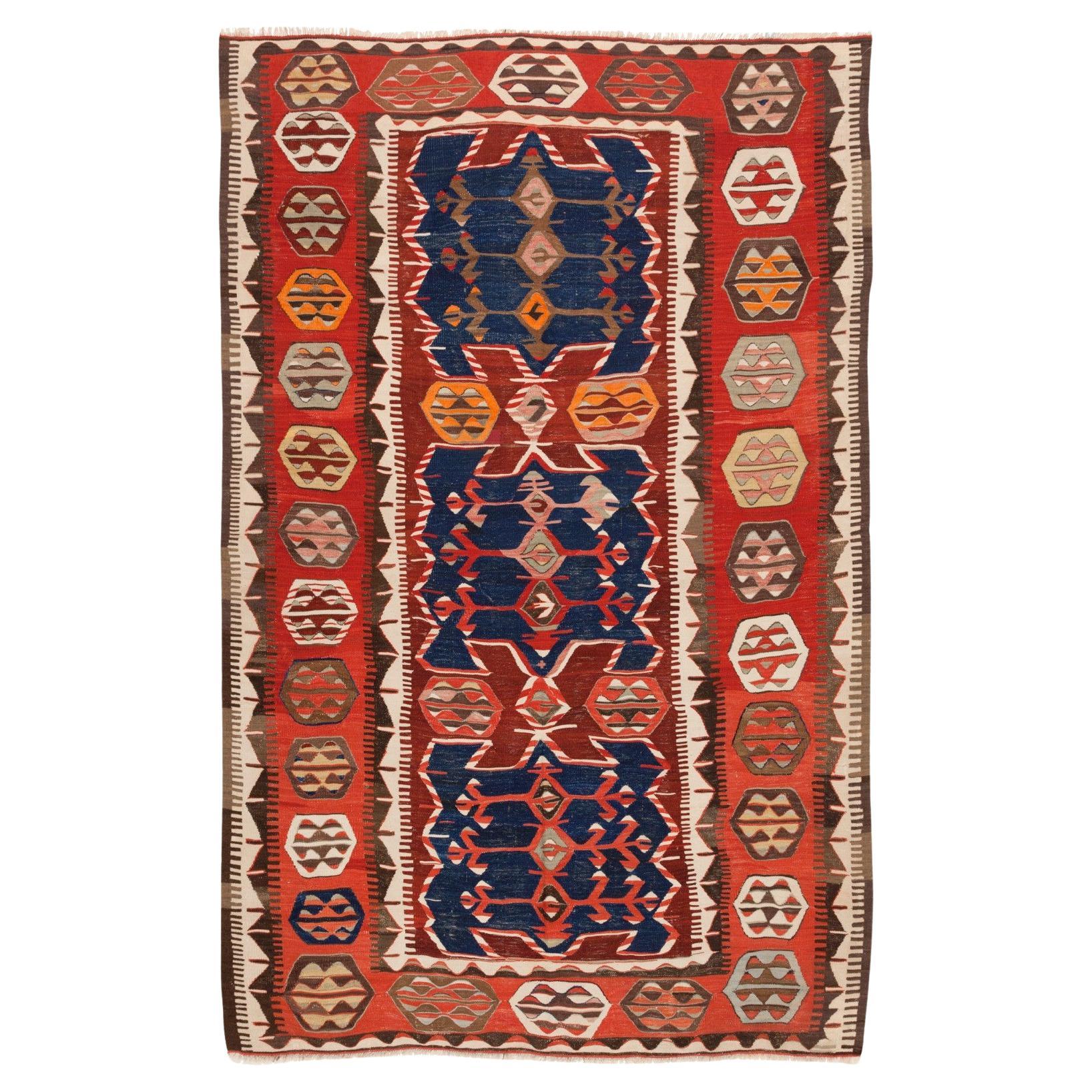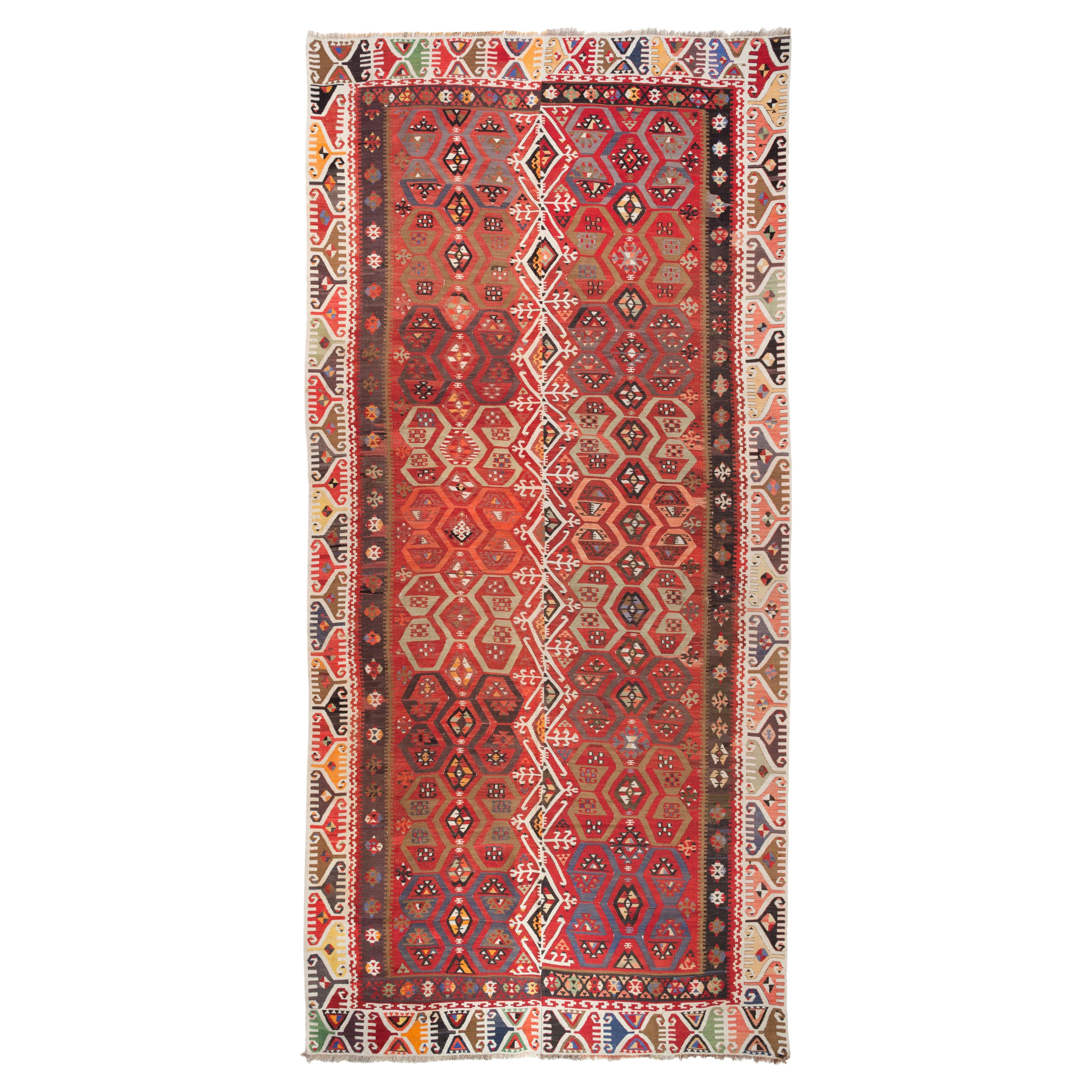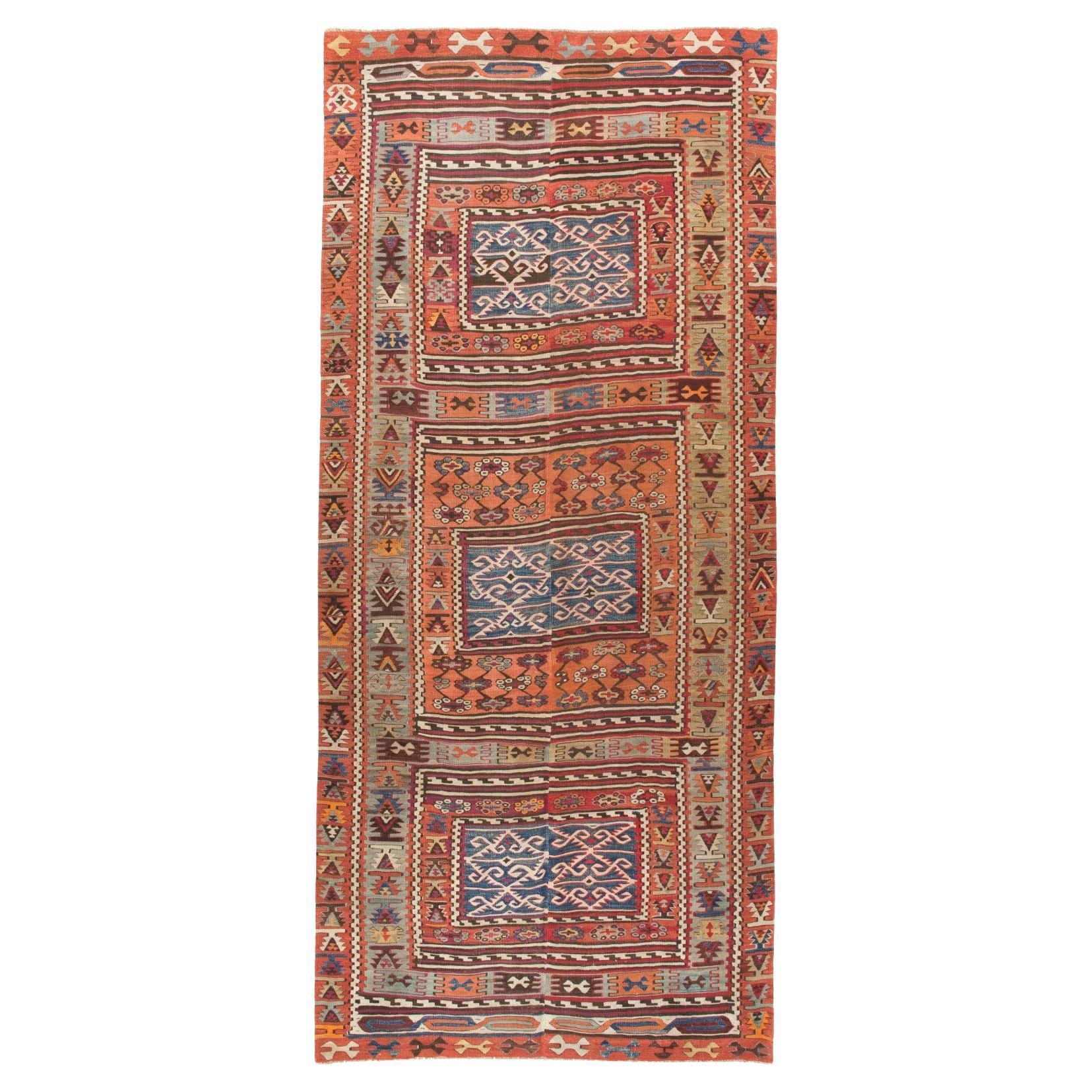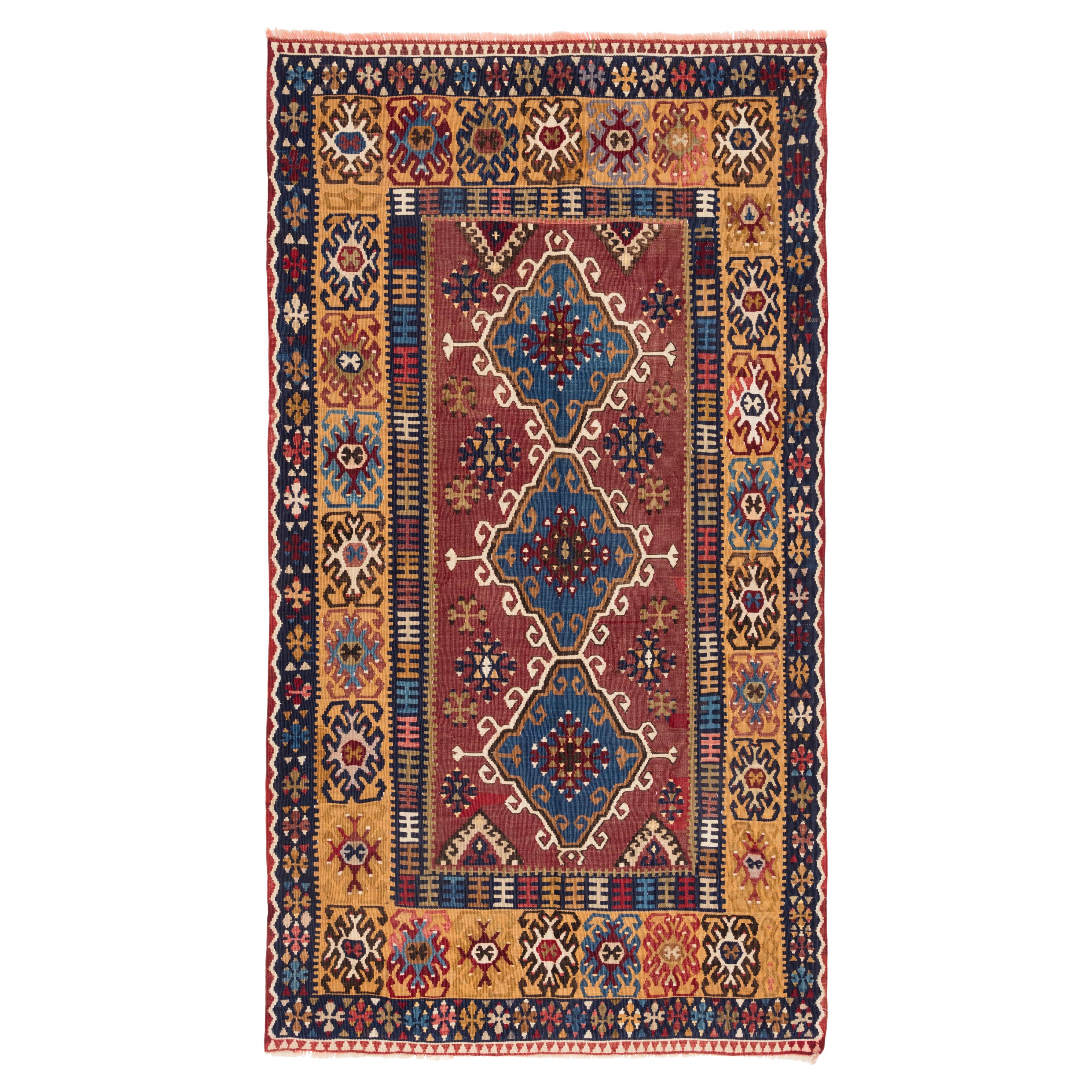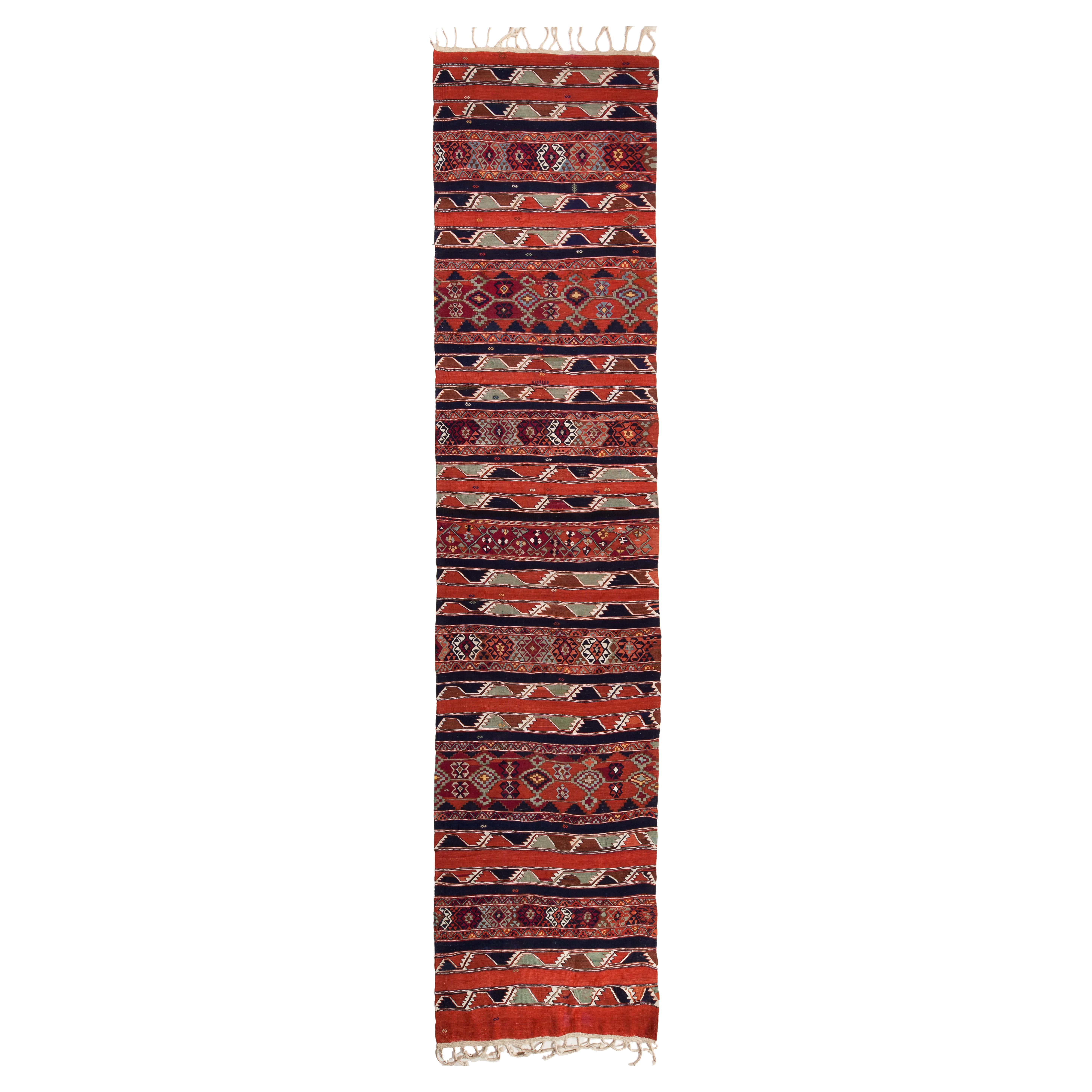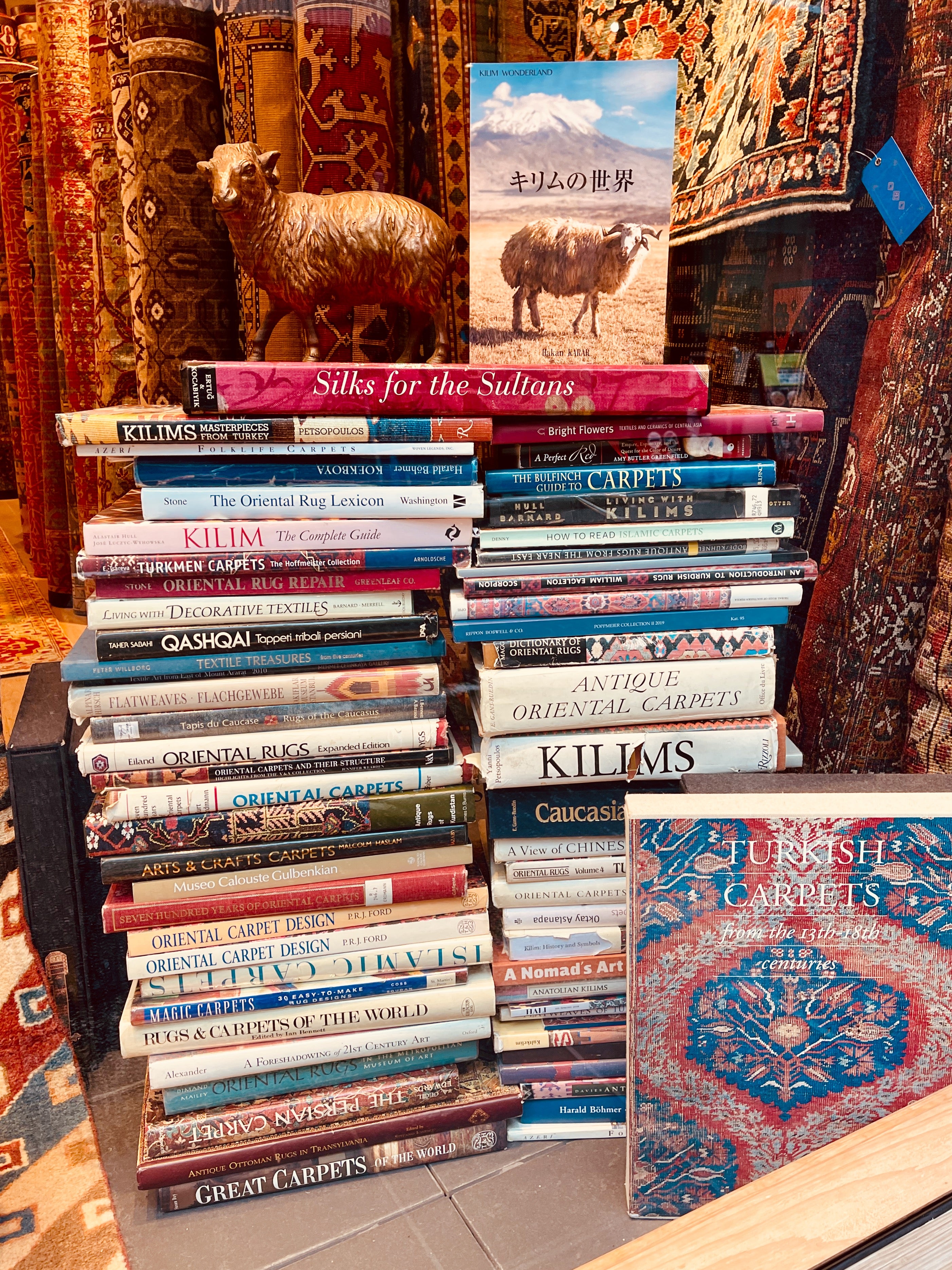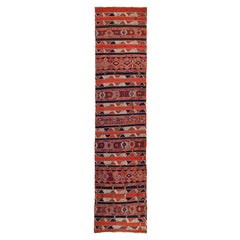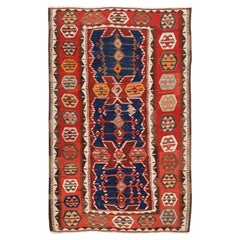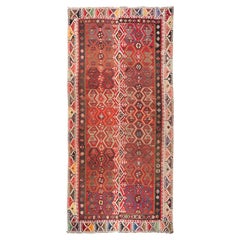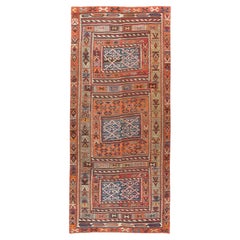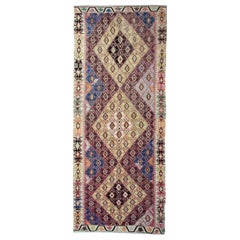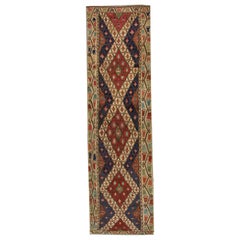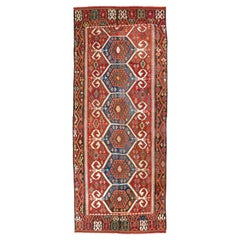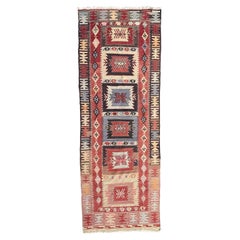Items Similar to Antique Konya Hotamis Runner Kilim Central Anatolian Rug Turkish Carpet
Video Loading
Want more images or videos?
Request additional images or videos from the seller
1 of 6
Antique Konya Hotamis Runner Kilim Central Anatolian Rug Turkish Carpet
$6,800
£5,163.40
€5,904.73
CA$9,500.59
A$10,566.73
CHF 5,517.62
MX$128,585.81
NOK 70,468.37
SEK 66,086.90
DKK 44,069.30
Shipping
Retrieving quote...The 1stDibs Promise:
Authenticity Guarantee,
Money-Back Guarantee,
24-Hour Cancellation
About the Item
This is Central Anatolian antique Kilim from the Konya - Hotamis region with a rare and beautiful color composition.
It belongs to the scallop from the Konya region of Central Anatolia. This old kilim has a wonderful faded color and texture that is typical of an old kilim in good condition. Orange, red, and blue are particularly good shades. This indescribable color is not only a result of dyeing but also a shade that has been created by adding the essence of a long time. For the inner border, the red and orange colors that have been used together for a long time are blended together as if they were assimilating each other. The abrash seen in each color is also very attractive. Perhaps the original contrast of kilim is clear, but now it shows a calm atmosphere to us who live in the present age. There is also a taste that you can see the slit like a kilim. The partial color change and the randomness and freedom of the pattern are proof of the original homemade handwoven fabric. Soft mocha teas accompanied by reds and oranges provide a warm atmosphere, and the overall tone is subtly nuanced and unique. It is a piece that allows you to feel the beauty of Kilim-like colors and the texture of the old in the best condition.
As early as the 13th century Marco Polo noted, in his account of his travels to the region, that superlative rugs were to be found in the Konya area. Fortunately, the art of weaving good kilims has not totally died out even today, for there are small quantities of kilims still being made with hand-spun wool and mainly natural colors. As the capacity for such production is not large and prices remain high, it is unlikely that commercialism will corrupt these enterprises.
Konya, in south-central Anatolia, was the capital of the Seljuk Empire from the mid-eleventh to the thirteenth century and was in its prime during that period. Many of Konya's impressive buildings were constructed at that time by the Seljuk sultans in an architectural style reflecting Persian and Byzantine influence. Previously known as Iconium, this is one of the oldest urban centers in the world: according to Phrygian legend, Konya was the first city to rise from the waters after the great flood. Excavations here have revealed bones from the Bronze Age (c. 3000 BC). In the third century, the town was mainly occupied by the Greeks.
Konya has always been an important center for religion, culture, and trade, and also as a collection point for the many weaving centers nearby. The mystical order of the Whirling Dervishes was established in the town in the twelfth century by Mevlana Celal ad-Din ar-Rumi, an Afghan from Balkh, and a dervish festival is held in Konya during December. This festival is tolerated but has suffered government oppression since the time of Ataturk. During Ottoman times the dervishes were powerful, but Ataturk viewed the group as contrary to the modern development of Turkey, and many monasteries have now been turned into museums. Konya continues to be a very religious place, and presently is becoming even more so.
Konya kilims feature the most varied compositions found in Anatolia, and there have been a great number of kilims made there over the centuries. Old Konya kilims still occasionally appear on the market today - but not necessarily in Konya itself. Although patterns are very diverse, they generally have much decoration covering the whole field of the kilim - a design format of large hexagonal motifs with extending hooked arms is a well-known characteristic. Again, a great variety of colors is used, most often of a lighter palette than in eastern Anatolia. Some very fine kilims have emerged, but in general, the kilims are of the medium-fine texture of weave, mostly made in slitweave technique with some çiçim. New kilims tend to be woven on thick warps. Konya kilims are made in all sizes, although there is fewer medium size. Ladik, Çumra and Eregli all lie close to Konya. Ladik is best known for its carpet production. It does, however, produce kilims that often have tulip motifs incorporated into the design. Weaving in Çumra has long since ceased, but the kilims that still remain are very similar. Recent Eregli kilims are well made with good wool and tend towards the dark colors that greatly benefit from sun-fading.
- Dimensions:Width: 45.28 in (115 cm)Length: 116.54 in (296 cm)
- Style:Kilim (In the Style Of)
- Materials and Techniques:
- Place of Origin:
- Period:
- Date of Manufacture:circa 1900s
- Condition:Repaired: Minor repairs, with antique natural dyed wool threads by our repair specialists. Wear consistent with age and use. Minor fading.
- Seller Location:Tokyo, JP
- Reference Number:Seller: 237211stDibs: LU8206233563042
ARARAT RUGS
We know and believe that the geography we come from, our past, and our lifestyle are the most important bond between us to carry the oriental carpet art and culture to the next generations along with our core values in our ongoing growth journey.
We are aware that the way to achieve this goal and carry this priceless art and culture to the future depends on a lot of work with all our people every day while adhering to our core values.
For us, art is meaningful in the sense that it brings together various cultures around the world. It is an honor for us that oriental carpet art and culture have been instrumental in this for centuries and that we are a part of this business.
We are tirelessly keeping an eye on auction house information around the world about carpets. New York's Metropolitan, London's Victoria & Albert Museums, and other famous art museums, as well as small specialized museums that house private collections, and books about oriental carpets to collect information on outstanding carpet designs and patterns from around the world. It's our Self-improving and Self-developing culture.
As Turkish Culture of Hospitality, the Kurdish Culture of Generosity, and as Japanese Culture of Business Punctuality; are the most important values that this multicultural background has taught and bequeathed to us. It is essential and valuable for us that you feel this feeling not only by looking at our oriental carpets but from the moment you contact us.
About the Seller
5.0
Platinum Seller
Premium sellers with a 4.7+ rating and 24-hour response times
Established in 1970
1stDibs seller since 2023
55 sales on 1stDibs
Typical response time: 3 hours
- ShippingRetrieving quote...Shipping from: Tokyo, Japan
- Return Policy
Authenticity Guarantee
In the unlikely event there’s an issue with an item’s authenticity, contact us within 1 year for a full refund. DetailsMoney-Back Guarantee
If your item is not as described, is damaged in transit, or does not arrive, contact us within 7 days for a full refund. Details24-Hour Cancellation
You have a 24-hour grace period in which to reconsider your purchase, with no questions asked.Vetted Professional Sellers
Our world-class sellers must adhere to strict standards for service and quality, maintaining the integrity of our listings.Price-Match Guarantee
If you find that a seller listed the same item for a lower price elsewhere, we’ll match it.Trusted Global Delivery
Our best-in-class carrier network provides specialized shipping options worldwide, including custom delivery.More From This Seller
View AllAntique Malatya Runner Kilim Rug South Eastern Anatolia Turkish Natural Carpet
Located in Tokyo, JP
This is a South Eastern Anatolian Antique runner Kilim from the Malatya region with a rare and beautiful color composition.
Malatya is Turkey's main kilim production area, and there are many variations. This is one of them, a runner-type kilim. The thread is thin and the weave is very fine and dense. Some metallic threads are used in this antique kilim, which is rarely seen in Anatolian kilims. Red, navy blue, and gray are the colors that determine the impression of this kilim. Other colors such as brown, yellow, and light blue are also used in the patterns. The wavy horizontal striped pattern, plain pattern, and lined motif pattern are woven together to create a kilim that looks like an obi.
The pattern of the motif and the pattern of the wave are about the same amounts, giving a lively impression without getting busy. The deep shades of colors and patterns that are familiar to each other are unique to antiques. However, it still retains good coloring which makes it hard to believe that it is antique. The runner type is a good type to make this kilim unique. Also, for those who want to create a different kind of home, the use of runners is very effective.
Malatya is a town built on one main street that continues for several miles. It is situated in the Tohmasuyu River basin which is encircled by the high peaks of the eastern Taurus Mountains. This is a fertile agricultural region, particularly for apricots, and has been a prolific weaving area for many years. The modern town was established in 1838; old Malatya, which is close by, was once an important city in Armenia Minor. In Roman times it was important as a garrison town on the eastern frontier, and the settlement came under Ottoman rule in the early fifteenth century. Considering the number of kilims woven in this region there is a surprising lack of diversity in design, especially in the larger kilims; this is possibly a direct result of the Kurdish tribal tradition of weaving only one type of design. Small prayer rugs...
Category
Early 20th Century Turkish Kilim Turkish Rugs
Materials
Wool, Natural Fiber
Antique Konya Obruk Kilim Central Anatolian Rug Vintage Turkish Carpet
Located in Tokyo, JP
This is Central Anatolian Antique Kilim from the Konya - Obruk region with a rare and beautiful color composition.
This highly collectible antique kilim has a wonderful special col...
Category
Early 20th Century Turkish Kilim Turkish Rugs
Materials
Wool, Natural Fiber
Old Adana Kilim Southern Anatolian Carpet Turkish Rug Central Anatolian Style
Located in Tokyo, JP
This is a Southern Anatolian made in two halves of old Kilim from the Adana region. It has a rare and beautiful color composition, similar to central Anatolian motifs and design.
Ad...
Category
Mid-20th Century Turkish Kilim Turkish Rugs
Materials
Wool, Natural Fiber
Antique Corum Kilim Rug Wool Old Central Anatolian Turkish Carpet
Located in Tokyo, JP
This is Central Anatolian Antique Kilim from the Corum region with a rare and beautiful color composition.
Corum has a long history as a base for Hittite ruins such as Hattusa, the ...
Category
Early 20th Century Turkish Kilim Turkish Rugs
Materials
Wool, Natural Fiber
Antique Yahyali Kayseri Kilim Central Anatolia Old Rug Turkish Wool Carpet
Located in Tokyo, JP
This is an antique Central Anatolian Kilim from the Yahyali region in Kayseri with a rare and beautiful color composition.
The earliest recorded occupation of Kayseri dates back to ...
Category
Mid-20th Century Turkish Kilim Turkish Rugs
Materials
Wool, Natural Fiber
Antique Malatya Runner Kilim Rug Anatolia Turkish Natural Carpet
Located in Tokyo, JP
This is a South Eastern Anatolian Antique runner Kilim from the Malatya region with a rare and beautiful color composition.
Malatya is Turkey's main kilim production area, and the...
Category
Early 20th Century Turkish Kilim Turkish Rugs
Materials
Wool, Natural Fiber
You May Also Like
Antique Rug, Handmade Carpet Oriental Rug Turkish Kilim Runner
Located in Wembley, GB
This handmade carpet colorful rug is a Turkish carpet rug has woven by very skilled weavers in Turkey, who used the highest quality wool and cotton. The flat-weave rug has a light or...
Category
Antique 1880s Turkish Kilim Turkish Rugs
Materials
Wool, Cotton, Organic Material
$5,923 Sale Price
20% Off
Oriental Kilim Runner Turkish Rug, Antique Rugs, Handmade Carpet for Sale
Located in Wembley, GB
These are kilim rug handmade carpet Oriental rug antique runner rugs from Konya, which is located in the heart of Turkey. These large rugs are in excellent condition. The workshop Kilims of Konya are mostly known for their distinctive geometric rugs and runners design. This tribal rug has an all-over design with repeating patterns. These extra-large rugs look beautiful and are ideal for stair runners or also they could be used as a bedroom runner rug.
Oriental Kilim runner Turkish rug, antique rugs, handmade carpet runners sale.
Category
Antique 1890s Turkish Kilim Turkish Rugs
Materials
Wool, Cotton, Organic Material
$4,168 Sale Price
20% Off
Free Shipping
5.6x13.5 Ft Antique Anatolian Konya Kilim, Ca 1880, Flat-Weave Rug
Located in Spring Valley, NY
A splendid antique Kilim flat-woven rug from Central Anatolia in excellent condition. Traditionally the rug is finely handwoven in two panels and connected in the centre, it is made ...
Category
Antique Late 19th Century Turkish Kilim Turkish Rugs
Materials
Wool
$5,125 Sale Price
50% Off
Free Shipping
Bobyrug’s Nice Vintage Anatolian Turkish Kilim
Located in Saint Ouen, FR
Very beautiful midcentury long Kilim, with a geometrical design and nice colors with red, blue, yellow, pink and purple, entirely handwoven with wool on cotton.
✨✨✨
"Experience the ...
Category
Mid-20th Century Turkish Kazak Turkish Rugs
Materials
Wool
$2,455 Sale Price
20% Off
Antique Rug, Anatolian Handmade Carpet Runner, Oriental Rug Turkish Kilim Runner
Located in Wembley, GB
This handmade carpet colourful Rug is a Turkish carpet rug has woven by very skilled weavers in Turkey, who used the highest quality wool and cotton. The flat-weave rug has a light o...
Category
Antique 1880s Turkish Kilim Turkish Rugs
Materials
Wool, Cotton, Organic Material
$5,342 Sale Price
20% Off
Early 20th Century Turkish Konya Kilim
Located in Chicago, IL
A stunning early 20th century Turkish Konya kilim rug with a fantastic bold tribal pattern containing two large stylized floral medallions amidst a field of more stylized flowers, su...
Category
Vintage 1940s Turkish Kilim Turkish Rugs
Materials
Wool
More Ways To Browse
Scalloped Ottoman
Crystal Stoppers
Crystal Vase With Silver
Fabric Recliner
German Collector Plate
Mahogany Ball And Claw
Oak Veneer Coffee Table
Rounded Corners Dining Table
Trestle Table Base
White Travertine Table
Wood Lattice
Antique Furniture With Wheels
Antique Manuscript
Italian Post Modern Sofa
Pair Of Mid Century Console Tables
Plate With Lion
Thonet Mid Century Modern
Vintage Wooden Office Chair
